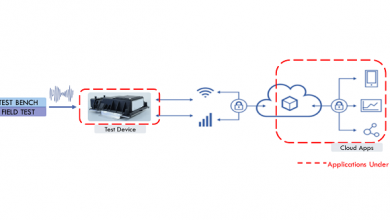Connected Vehicles and Mobile Edge Computing – A Marriage of Convenience

With the emergence of cloud computing, there has been a change in perception about the way that information management resources are deployed and how information is distributed and consumed. The idea behind cloud computing is to separate data from the potential limitations associated with physical hardware. By hosting applications and data storage in the cloud the physical proximity of the data that needs to be processed and accessed becomes remote. This places extra demands on the networks that connect the hyperscale cloud data centres to their end users. With 5G and its evolutions, users will expect the connected society to be available with no limitations, and users will make use of bandwidth-demanding services like augmented reality and virtual office applications, also when on the move.
Amongst other things, 5G is forever expected to change the way we drive! The automotive industry is on a path where vehicles are continuously becoming more aware of their environment due to the addition of various types of integrated sensors. At the same time, the amount of automation in vehicles increases, which – with some intermediate steps – will eventually culminate in fully-automated driving without human intervention.
Due to connectivity and driven by new 5G technologies, the value chain is transforming into a value network. Along this path, the number of interactions increases, both in-between vehicles, between vehicles and other road users, and with an increasingly intelligent road infrastructure. Therefore, the significance and reliance on capable communication systems for vehicle-to-anything (V2X) communication is becoming a key asset that will enhance the performance of automated driving and increase further road traffic safety with combination of sensor-based technologies.
This challenge is brought into sharp focus when we consider the processing needs of new applications and services, including Artificial Intelligence, the ‘Internet of Things’ and the need to process and access data in near real-time. Cloud computing brings the convenience of virtualisation to some extent, but it is not an ideal approach for real-time data collection, processing, and analysis. High speed of the vehicles, dynamic surroundings often cluttered with static and mobile scatterers, and low antenna heights create challenges for V2X communications that are unique compared to other communication systems.
A solution to this is ironically, to move elements of the physical infrastructure closer to where the data needs to be processed. This idea is referred to as ‘Edge Computing’. In the context of mobile communications, and as 5G networks with their processing power come onstream, edge computing becomes a necessity. Edge computing works by using the physical characteristics of the existing mobile network. For the sake of convenience let us define the edge of the network as the point of the network closest to the connected devices that are generating the data. At the edge of a mobile communications network or indeed any communications network, there are opportunities to locate servers and even data storage closer to the users – we can think of a user as a human or a machine in this context. This approach reduces round-trip latency.
In a network designed for edge computing and 5G is very much the case in point, there are three approaches, which we can refer to as:
- Cellular unassisted V2V: Embedded Edge
- Cellular V2X: RAN, Private 5G
- Cellular-assisted V2V: Remote edge
5G lends itself well to the idea of mobile edge computing, which is also referred to as multi-access edge computing or MEC. Benefits with MEC include:
Minimal latency: Relying on the cloud is not ideal for some automotive applications, as cloud-based services are relatively slow. As automotive applications are coming to rely increasingly on AI enabled applications, this disqualifies the cloud for use in many automotive applications, such as ADAS and autonomous vehicle applications. Servers and processing power located in more compact data centre enclosures closer to where their processes will be accessed and used, solves this latency issue associated with the cloud. It could also create a new market for computing services that cloud architecture is not able to address. In the case of a connected vehicle, having this processing power closer to the connected vehicles improves processing speed, which means that real-time analytics and control becomes feasible.
Maintenance: The sort of micro-data centres envisaged to support MEC are designed for accessibility and ease of maintenance, with just enough servers for hosting real-time critical functions. This combination of accessibility and the modular nature of what will be needed in these environments not only facilitates maintenance but also ensures redundancy, as when one site is being managed, other proximate sites can temporarily take on the load.
Climate: There is appeal to the idea of distributing computing power, in smaller physically distributed facilities, as opposed to huge, centralised data centres. Quite part from the electricity required to power both the processing and the cooling in large data centres, there are considerations about redundancy of connectivity.
For connected vehicle applications, while MEC brings advantages, there are also challenges to be considered. An obvious one is the physical scope to deploy MEC. While mobile base stations are regarded as the preferred location to deploy the edge servers, not all base station enclosures have the room to do so. There are also security concerns, with people being able to tamper with or even remove servers from remote locations. Another consideration is the feasibility of providing 3-Phase power supplies to power the extra equipment to some remote locations.
These challenges need to be weighed against an objective assessment of the longer-term sustainability of the public cloud model. With increasing demands for connected vehicle applications, operating in near real-time, with increasing volumes of data being generated, then the public cloud model needs to change. If location matters and in the case of automotive applications this is the case, this means that approach to enterprise computing needs to change. The hyperscale, centralized cloud data centre model needs to give way to smaller, localised processing points, more cost-effective operating models, and a distributed location architecture.
For connected vehicles, the marriage of 5G and MEC reduces the strain on mobile networks as an increasing number of vehicles become connected and generate an increasing amount of data (Telematics, Diagnostics, Infotainment, Location based services, V-Commerce etc). This distributed approach to data processing at the edge of the mobile network ensures that more connected vehicles and the data they are exchanging can be supported – so more vehicles can be accommodated on the existing networks as well as more data being processed. Combining 5G and MEC, instead of each individual connected vehicle regularly sending information to the network, data can be cached and transferred to the main framework as required.
Advantage Explanation

A Hybrid Future
As the assertion has been made that for connected vehicle applications, reliance on public cloud in its present form is not sustainable, then MEC does present a viable alternative approach, despite the challenges indicated above.
The implication of moving more processing to the network edge takes us from the realms of information technology towards operational technology (OT). The reason for this is that with more emphasis and focus coming onto the edge infrastructure, the people who will be managing the infrastructure will be those who, up until now, have been responsible for maintenance and software support. Thus, to support this new mobile edge paradigm we see a shift towards more focus on operational technology for the mobile network operators.
Another emerging concept is the idea of the ‘Edge Cloud’, a kind of hybrid approach which is effectively a collection of multiple physical edge deployment, collected in a single ‘virtual’ platform. With this approach mobile network operators will have an opportunity to offer public-cloud type services, including SaaS and virtual server hosting.
What could these changes mean for automotive OEMs? The clear message is that for connected vehicle applications, requiring real-time or close to real-time processing need the support of a new architecture approach from the mobile network operators. Reliance on cloud-based applications for certain types of telematics use cases, ADAS or autonomous vehicle services is not realistic. Anything that can introduce lower latency data processing is a bonus, but 5G can do this on its own. The beauty of a combination of 5G with MEC is the new use cases it could open up for automotive OEMs, with an array of V2X services and revenue earning opportunities. A distributed edge architecture brings both the speed and volume of data to be processed and acted upon into reach. The use of AI for deterministic applications, such as which network connection is best to use, when and where to perform an OTA update, how to connect a vehicle with the infrastructure around it are all requirements that a combination of 5G with MEC can help fulfil.
Author:

Bhaskar Ghose
Deputy General Manager
Tata Communications Automotive Business Unit
Published in Telematics Wire


